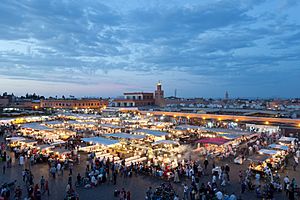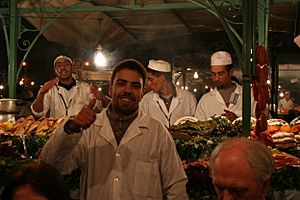Jemaa el-Fnaa facts for kids
Jemaa el-Fnaa is a famous square and market in Marrakesh, a city in Morocco. It's located in the old part of the city, known as the medina quarter. This square is a very important place for both local people and tourists who visit Marrakesh. It's often called the heart of the city because of all the activities happening there.
Contents
What Does Jemaa el-Fnaa Mean?
The name Jemaa el-Fnaa comes from the Arabic language. The word Jamaa means "congregation" or "gathering." This might refer to an old mosque that was once in the area.
The second part, el Fnaʼ, has a few possible meanings. It could mean "death" or "an open space in front of a building." Some people think it means "the gathering area," which makes sense for a busy market square. Another idea is "The Mosque at the End of the World." There's also a belief that it refers to a mosque with a special courtyard. Historically, some events that happened here led to the name "assembly of the dead."
A Look Back at Jemaa el-Fnaa's History

The city of Marrakesh was founded a long time ago, between 1070 and 1072, by a group called the Almorabits. Later, in 1147, another group called the Almohads took control of the city after a big struggle.
After this, Jemaa el-Fnaa and many other parts of Marrakesh were rebuilt and improved. The areas around the square, like the mosque, palace, hospital, and gardens, were also updated. The city's fortress, called the kasbah, was made stronger. Over time, as Marrakesh changed, Jemaa el-Fnaa also had its ups and downs, with periods of decline and then new life.
Life in the Square: Day and Night
During the day, Jemaa el-Fnaa is a lively place. You can find many stalls selling fresh orange juice. There are also water sellers dressed in traditional clothes, carrying leather bags and brass cups. Sometimes, you might see people with Barbary apes or snake charmers. However, these animals are protected by Moroccan law.
As the day goes on, the entertainment changes. The snake charmers leave, and the square gets even busier. You might see young boys dancing, as it's not traditional for girls to perform this way. Storytellers gather crowds, sharing tales in Berber languages or Arabic language. There are also magicians and sellers of traditional medicines.
When it gets dark, the square completely transforms. Dozens of food stalls open up, filling the air with delicious smells. This is when the most people are usually in the square, enjoying the food and the atmosphere.
One side of the square is next to the Marrakesh Souq, which is a traditional market. In the souq, you can find things locals need every day, as well as souvenirs for tourists. On other sides of the square, there are hotels, gardens, and cafes with outdoor seating. Narrow streets lead from the square into the winding alleys of the medina.
Years ago, Jemaa el-Fnaa was a bus station. But in the early 2000s, it was closed to vehicles to make it safer and more enjoyable for people. The local authorities know how important the square is for tourism. Because of this, there is a strong but quiet police presence to make sure visitors are safe.
Images for kids
See also
 In Spanish: Plaza de Yamaa el Fna para niños
In Spanish: Plaza de Yamaa el Fna para niños









